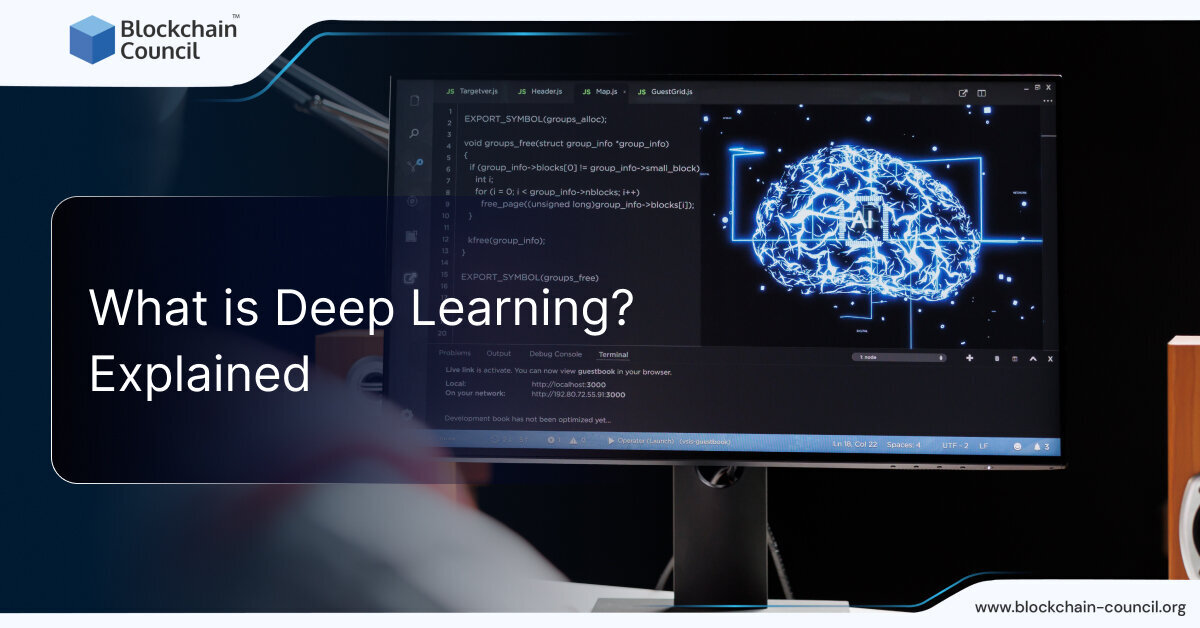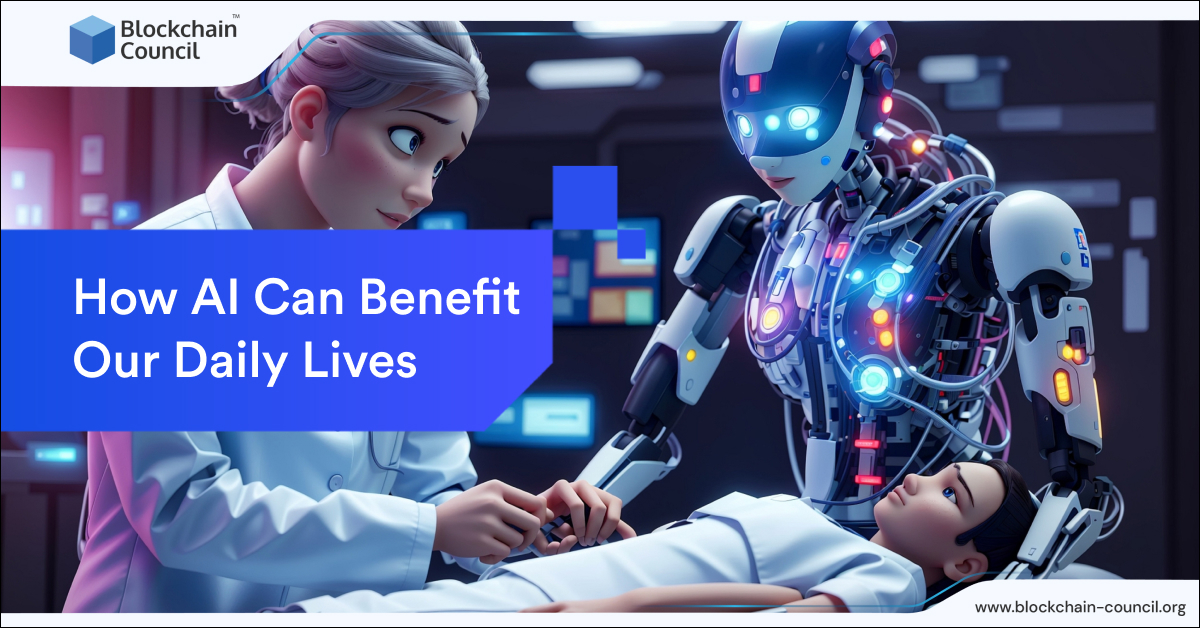
- Blockchain Council
- September 13, 2024
Summary
- Deep Learning is a critical innovation in artificial intelligence that is driving advancements in various sectors, including healthcare and finance.
- A study from 2023 showed that 77% of organizations have already adopted AI, and 98% plan to do so in the next five years.
- Deep Learning has seen a 600% growth in the use of algorithms since 2018, highlighting its potential for digital transformation across industries.
- Deep Learning involves the use of multi-layered neural networks to progressively extract higher-level features from raw input, mirroring human learning processes.
- It distinguishes itself from traditional machine learning by automatically identifying and using features for data classification.
- Deep Learning has a historical evolution, with key milestones like the development of perceptrons, backpropagation, and Geoffrey Hinton’s breakthrough in 2006.
- The learning process of Deep Learning models involves data collection, model design, training, backpropagation, validation, testing, and continuous improvement.
- Deep Learning has applications in healthcare, autonomous vehicles, natural language processing, financial fraud detection, e-commerce, agriculture, entertainment, energy, manufacturing, and drug discovery.
- Challenges in Deep Learning include data requirements, computational resources, interpretability, overfitting, and adaptability to new tasks.
- Future trends in Deep Learning include hybrid AI, self-supervised learning, improved interpretability, and energy-efficient models, promising continued growth and innovation in the field.
Deep Learning, a profound innovation in the realm of artificial intelligence, stands at the forefront of technological evolution, transforming how we interact with the world around us. As we delve into 2024, the landscape of Deep Learning continues to expand and astound, fueling significant strides in various sectors, from healthcare to finance, and beyond.
In recent years, Deep Learning has witnessed remarkable advancements, signifying its pivotal role in the AI revolution. A study conducted in 2023 revealed that an overwhelming 77% of organizations have integrated AI into their operations, with a staggering 98% planning to adopt it within the next five years.
This surge in AI adoption is not just a trend but a testament to the tangible financial benefits that enterprises have experienced, with a 600% growth in the use of Deep Learning algorithms since 2018. This exponential rise underscores Deep Learning’s potential to revolutionize digital transformation initiatives across various industries
Definition of Deep Learning
Basic Explanation
Deep Learning, a pivotal subset of machine learning, represents a sophisticated class of algorithms characterized by their use of multiple layers to progressively extract higher-level features from raw input. This concept can be likened to the human learning process, where a deeper understanding is developed from basic concepts to complex structures. For instance, in image processing, initial layers might identify simple elements like edges, while advanced layers recognize complex patterns like faces or objects. This hierarchical feature extraction allows Deep Learning models to handle a wide array of complex tasks with high proficiency.
Deep Learning systems are typically built upon multi-layered artificial neural networks, including structures like convolutional neural networks and transformers. These networks mirror the human brain’s structure, with numerous layers (or “neurons”) working in tandem to process and interpret data. The term “deep” in Deep Learning signifies the multiple layers through which data is transformed, making these systems capable of handling complex, unstructured data like images, text, and audio with remarkable accuracy.
Distinction from Machine Learning and Artificial Intelligence
Deep Learning differentiates itself from traditional machine learning through its ability to automatically identify and use the appropriate features for data classification, without needing explicit programming for feature extraction. Traditional machine learning models, in contrast, often rely on manual feature identification and are more suited to structured, labeled data. While machine learning encompasses a broad range of algorithms and techniques, Deep Learning specifically refers to those utilizing deep neural networks.
In the broader scope, both Deep Learning and machine learning fall under the umbrella of artificial intelligence (AI), which is the overarching field focused on creating machines capable of performing tasks that typically require human intelligence. AI encompasses everything from basic rule-based systems to complex neural networks, while Deep Learning represents a more specific, advanced subset of this vast field.
Historical Context
Brief History
The history of Deep Learning can be traced back several decades, as it has evolved alongside advancements in computational power and data availability. Initially conceptualized as a means of mimicking the human brain’s functionality, Deep Learning has undergone significant transformations, shaped by key technological advancements and theoretical breakthroughs.
Key Milestones and Technological Advancements
- 1950s – Early Concepts: The foundation for neural networks and, consequently, Deep Learning was laid in the 1950s. The idea of creating a machine that mimics the human brain’s functionality began to take shape during this era.
- 1960s – Perceptrons: In the 1960s, Frank Rosenblatt developed the perceptron, an early neural network, which marked a significant step forward in AI research. However, limitations in understanding and computing power hindered further progress.
- 1980s – Revival and Backpropagation: A major revival in neural network research occurred in the 1980s. A key development was the invention of the backpropagation algorithm, which allowed networks to adjust their internal parameters effectively. This was critical for training deep neural networks.
- 1990s – Support Vector Machines: The 1990s witnessed a shift in focus towards alternative methods like Support Vector Machines (SVMs). Although Deep Learning was not the primary focus during this decade, the foundational work continued.
- 2006 – Geoffrey Hinton’s Breakthrough: In 2006, Geoffrey Hinton and his colleagues introduced a method to effectively train deep neural networks, marking the beginning of the modern era of Deep Learning. This was a pivotal moment, reviving interest in the field.
- 2010s – Major Advances and Applications: The 2010s saw significant advances in Deep Learning, driven by increased computational power and data availability. Key developments during this period include:
- 2012: AlexNet, a deep convolutional neural network, won the ImageNet competition by a large margin, showcasing the power of Deep Learning in image recognition.
- 2014: Generative Adversarial Networks (GANs) were introduced, revolutionizing the field of generative models.
- 2015: Residual Networks (ResNets) made training extremely deep networks feasible.
- 2018: BERT (Bidirectional Encoder Representations from Transformers) transformed the field of natural language processing.
- 2020s – Ongoing Development: The current decade continues to witness rapid advancements in Deep Learning, with research focusing on more efficient training methods, reducing the environmental impact, and addressing ethical concerns in AI.
Learning Process
How Deep Learning Models Learn from Data
The learning process of Deep Learning models involves several intricate steps, each contributing to the model’s ability to make accurate predictions or decisions based on data. Here is a step-by-step guide on how these models learn from data:
Step 1: Data Collection and Preprocessing
- Data Collection: The first step involves gathering a large and diverse set of data relevant to the problem at hand. This data can be in various forms, such as images, text, or numerical values.
- Preprocessing: Once collected, the data is preprocessed. This step includes cleaning the data, handling missing values, normalizing or scaling numerical values, and possibly converting the data into a format suitable for the neural network.
Step 2: Model Design
- Selecting the Model Architecture: The architecture of a neural network (like CNNs for image data or RNNs for sequential data) is chosen based on the type and complexity of the task.
- Defining Layers and Neurons: The network is structured with layers and neurons. This involves deciding the number of layers, the number of neurons in each layer, and how these neurons are interconnected.
Step 3: Training the Model
- Feeding the Data: The preprocessed data is fed into the neural network. This is typically done in batches to optimize memory usage and improve the training process.
- Forward Propagation: Each input passes through the layers of the network, with each neuron processing the input and passing it to the next layer.
- Loss Calculation: The model’s predictions are compared against the actual outputs, and the difference is measured using a loss function. This function quantifies how far the model’s predictions are from the actual values.
Step 4: Backpropagation and Optimization
- Backpropagation: This is a key step where the model learns from its errors. The gradient of the loss function is computed, and this information is propagated back through the network, updating the weights of the neurons in a way that minimizes the loss.
- Optimization: An optimization algorithm, like Stochastic Gradient Descent (SGD) or Adam, is used to adjust the weights of the connections between neurons in the network, based on the gradients computed during backpropagation.
Step 5: Validation
- Evaluating the Model: The model is evaluated on a separate validation dataset that was not used during training. This step checks how well the model generalizes to new data.
- Hyperparameter Tuning: Based on the model’s performance on the validation set, hyperparameters (like learning rate, number of layers, etc.) are adjusted to improve the model.
Step 6: Testing and Deployment
- Final Evaluation: After validation and adjustments, the model is tested on a testing dataset to assess its real-world performance.
- Deployment: Once the model achieves satisfactory performance, it is deployed for actual use, either in a production environment or for further experimental purposes.
Step 7: Iteration and Continuous Learning
- Iterative Improvement: Deep Learning models often undergo continuous improvements and retraining, especially as new data becomes available or when the model is used in changing environments.
- Fine-tuning and Transfer Learning: For certain applications, models are fine-tuned from pre-trained networks using transfer learning techniques, which can lead to better performance with less data.
Overfitting and Underfitting
- Overfitting: This occurs when a model learns the training data too well, including its noise and outliers, leading to poor performance on new data. It essentially memorizes the training dataset rather than learning to generalize from it.
- Underfitting: Conversely, underfitting happens when a model is too simplistic to capture the underlying pattern of the data. It fails to learn adequately from the training data, resulting in poor performance both on the training and new data.
Applications of Deep Learning
Deep Learning, a subset of machine learning characterized by algorithms based on artificial neural networks, has vast applications across various industries, demonstrating its versatility and effectiveness in solving complex tasks. Below is an overview of specific examples and companies utilizing Deep Learning.
1. Healthcare Diagnostics and Imaging
Deep Learning significantly enhances medical diagnostics and imaging. It’s used to identify diseases from medical images like X-rays, MRIs, and CT scans with remarkable accuracy, allowing for early and precise diagnoses of conditions such as cancer and heart disease.
2. Autonomous Vehicles and Transportation
The automotive industry leverages Deep Learning in developing self-driving cars. These vehicles use neural networks to interpret real-time data from sensors and cameras, enabling road navigation, pedestrian recognition, and collision avoidance. Companies like Tesla and Uber are actively involved in this space.
3. Natural Language Processing (NLP)
NLP has been transformed by Deep Learning, allowing computers to understand and generate human language. This includes chatbots, language translation, and sentiment analysis. Machine translation, powered by Deep Learning, is used in website localization, document translation, and language learning tools.
4. Financial Fraud Detection
Deep Learning aids in identifying fraudulent activities in the financial sector. It analyzes transaction data to detect unusual patterns, helping institutions like PayPal to protect their customers’ assets and maintain financial integrity.
5. E-commerce and Recommendation Systems
Platforms like Amazon and eBay use Deep Learning for personalized product recommendations. Algorithms analyze customer behavior and purchase history, enhancing the shopping experience and driving sales.
6. Agriculture and Crop Management
In agriculture, Deep Learning is employed for smarter and more efficient crop monitoring and precision farming. It analyzes data from drones and satellite images to optimize crop health, pest identification, and irrigation, aiding in sustainable farming practices.
7. Entertainment and Content Creation
The entertainment industry uses Deep Learning for creating content like realistic CGI in movies and composing music. It’s also instrumental in writing articles and other creative endeavors.
8. Energy and Power Grid Optimization
In the energy sector, Deep Learning optimizes power grid operations by predicting energy consumption patterns, thus aiding utilities in efficient power distribution.
9. Manufacturing and Quality Control
Deep Learning enhances manufacturing quality control by identifying defects and maintaining high standards, thereby improving product quality and reducing waste.
10. Drug Discovery and Development
The pharmaceutical industry benefits from Deep Learning in accelerating drug discovery. AI models predict potential drug candidates, speeding up research and the delivery of treatments.
Challenges in Deep Learning
Deep Learning, while a groundbreaking and versatile field, faces several significant challenges.
- Data Requirements: Deep Learning models generally require vast amounts of data for training. This necessity for large datasets can be a limitation, especially in fields where such data is scarce or expensive to obtain. Moreover, the quality of training data is crucial. Poorly annotated data can lead to inaccurate models, while acquiring high-quality, well-labeled data can be costly and time-consuming.
- Computational Resources: Training Deep Learning models is computationally intensive. It often requires powerful hardware, such as GPUs, and can be both time-consuming and expensive. This high computational cost limits the accessibility of Deep Learning technologies, especially for smaller organizations or individual researchers.
- Interpretability: Deep Learning models, particularly complex networks, are often considered “black boxes” due to their lack of interpretability. Understanding how these models make decisions is crucial, especially in sensitive areas like healthcare or autonomous vehicles, where explainability is essential for trust and reliability.
- Overfitting: Overfitting remains a critical issue in Deep Learning. Models can become too finely tuned to the training data, failing to generalize well to new, unseen data. Balancing model complexity and generalization is a key challenge in model design.
- Dynamic Functionality: Unlike human intelligence, current Deep Learning models struggle with adapting to new, unforeseen tasks without extensive retraining. Humans, on the other hand, can apply learned knowledge to a wide range of different tasks, a flexibility that Deep Learning models currently lack.
Future Trends in Deep Learning
Looking ahead, Deep Learning is set to break new ground in various domains. The introduction of novel approaches like Federated Learning and Generative Adversarial Networks (GANs) is reshaping the landscape of AI, offering enhanced data privacy and the generation of realistic data, respectively. These advancements, coupled with the concept of Explainable AI (XAI), are paving the way for more transparent, fair, and responsible AI systems. Moreover, the emergence of new algorithmic approaches, such as LocoProp and SGD with reverse experience replay, further enhance the efficiency and effectiveness of Deep Learning models. Here are some future trends in Deep Learning to look forward.
1. Hybrid AI
The integration of Deep Learning with other AI approaches, like symbolic AI, is an emerging trend. This hybrid approach aims to combine the pattern recognition strength of Deep Learning with the reasoning and planning capabilities of symbolic AI, moving closer to replicating human-like general intelligence.
2. Self-supervised Learning
Advancements in self-supervised learning, where models learn to understand and label data on their own, are reducing the dependence on large labeled datasets. This approach could address some of the data and computational challenges currently faced in the field.
3. Improved Interpretability
There is an ongoing effort to make Deep Learning models more interpretable and transparent. This advancement is crucial for applications in critical fields where understanding the model’s decision-making process is as important as the decision itself.
4. Energy-efficient Models
As concerns about the environmental impact of computing grow, developing more energy-efficient Deep Learning models is becoming a priority. This includes both optimizing existing algorithms and designing new ones that require less computational power.
Conclusion
Deep Learning has revolutionized numerous fields and continues to be a driving force in the advancement of AI. Despite its challenges, ongoing research and development promise to address these issues, paving the way for more efficient, interpretable, and versatile Deep Learning models. The increasing integration of Deep Learning in business operations underscores the growing need for professionals adept in AI programming, data analysis, and machine learning operations (MLOps) The field is poised for continued growth and innovation, with its applications expanding into new domains and improving existing technologies. The future of Deep Learning, with its blend of advanced techniques and practical applications, holds exciting potential for further transforming the technological landscape.
If you want to dive into the world of Deep Learning and other branches of AI, certifications will help you shine. Artificial Intelligence certifications by the Blockchain Council can take your career trajectory to new heights!
Disclaimer: The content on this platform is for educational purposes only. We do not endorse, recommend, or promote any product. Our articles are based on data from trustworthy sources, and our perspective is neutral and unbiased. Readers should make informed decisions and seek professional advice when needed. We have no affiliations with the products or services mentioned in our content.
Frequently Asked Questions
What is Deep Learning in simple words?
- Deep Learning is a subset of machine learning, which is a way for computers to learn from data.
- In Deep Learning, we use artificial neural networks that have multiple layers to understand and make sense of complex information.
- It’s like teaching a computer to think and make decisions by itself, but with the help of these layered networks.
Why do we need Deep Learning?
- Deep Learning is needed because it can handle very complex and unstructured data, such as images, text, and audio, with high accuracy.
- It can automatically extract important features from data without explicit programming, making it ideal for tasks like image recognition, natural language processing, and more.
- Deep Learning has enabled significant advancements in various fields, from healthcare and autonomous vehicles to finance and entertainment.
What is CNN in Deep Learning?
- CNN stands for Convolutional Neural Network, which is a type of Deep Learning model.
- CNNs are mainly used for image-related tasks, like image recognition and object detection.
- They work by applying filters and convolution operations to extract features from images, allowing them to understand patterns and objects within pictures.
Is Deep Learning an AI?
- Yes, Deep Learning is a subset of artificial intelligence (AI).
- AI is a broader field focused on creating machines that can perform tasks requiring human intelligence, while Deep Learning is a specific technique within AI.
- Deep Learning is a critical component of many AI systems, but AI encompasses various other methods and approaches beyond Deep Learning.





































































 Guides
Guides News
News Blockchain
Blockchain Cryptocurrency
& Digital Assets
Cryptocurrency
& Digital Assets Web3
Web3 Metaverse & NFTs
Metaverse & NFTs
